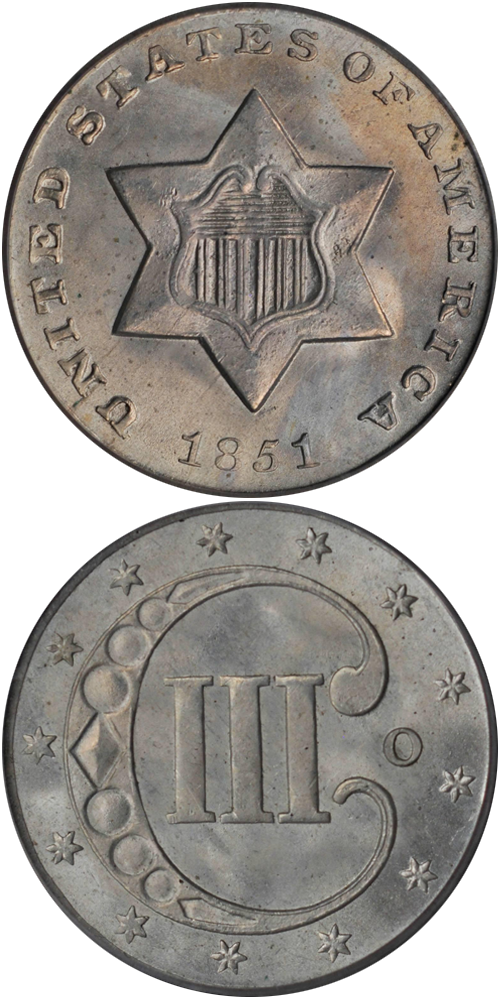Designed by: James Barton Longacre
Issue Dates: 1851-1853
Composition: 75% silver, 25% copper
Diameter: 14 mm
Weight: 0.80 grams (12.35 grains)
Edge: Plain
Business Strike Mintage: 36,230,940
The silver three-cent piece appeared in 1851 and was intended to facilitate the purchase of three-cent stamps at various post office outlets. The obverse of the 1851-1853 style bears a six-pointed star at the center, upon which is a shield. UNITED STATES OF AMERICA and the date are around the border. The reverse employs a C-shaped ornament enclosing the Roman numeral III, with 13 stars surrounding.
From the very outset, difficulties were experienced in striking the pieces up properly, with the result that many examples seen today are lightly impressed in one area or another or show adjustment marks (made at the Mint during the planchet preparation process). The small diameter of the coin evoked criticism. Although large quantities were produced during the early years of the series, particularly in 1852 and 1853, subsequent production declined, and the denomination never achieved widespread popularity.
With the exception of the 1851-0 (New Orleans Mint) issue, the only branch mint issue of the denomination, all varieties of the 1851-1853 coinage are readily available in grades from Good through Extremely Fine. As noted earlier, sharply struck pieces are elusive. AU coins are scarce, Uncirculated pieces are scarcer, and superb Uncirculated coins are quite rare.
Further Reading
Silver three-cent pieces were authorized by Congress on March 3, 1851. Ease of purchasing three-cent postage stamps was given as a reason for producing this new denomination. Most collectors today refer to these small coins simply as "silver three-cent pieces," although from time to time the term trime has been used, including in Mint correspondence.
Silver three-cent pieces coined from 1851 through 1853 inclusive bear a six-pointed star on the obverse and the Roman numeral III enclosed by an ornamental C-shaped device on the reverse. Prior to the issuance of pieces for circulation in 1851, patterns of varying designs were produced at the Mint. One of these patterns, described at the time as the ugliest of all American coins, is very simple in design: the obverse bears nothing but a 3 and the reverse consists only of III.
Whereas the standard for United States silver coins was an alloy consisting of nine parts silver and one part copper (the copper adding strength), silver three-cent pieces of the 1851-1853 years were made of a new composition consisting of 7½ parts silver and 2½ parts copper. 1854 and later issues reverted to the normal standard used for other silver denominations.
The most interesting early piece is the 1851-O issue produced at the New Orleans Mint. This particular coin has the distinction of being the only silver three-cent piece produced at a mint other than Philadelphia. In fact, it has an even greater distinction: it is the only piece of a denomination of less than five cents to be produced with a mintmark during the nineteenth century! In deference to readers who are interested in numismatic trivia, in 1837 some large cents were struck at the New Orleans Mint to test the dies. Unfortunately for collectors today, these did not bear mintmarks, so 1837-O cents are not a reality. It is not known if any examples were saved once die testing was completed.
From 1851 through 1853 more than 30 million silver three-cent pieces were produced, more than were made during all of the remaining years of the series from 1854 until the end in 1873. The slumping in interest in this denomination is similar to the trend in the two-cent and nickel three-cent series.
Examples of 1851-1853 coins are available in all grades from Good through Uncirculated. In the latter grade 1851-O is considerably scarcer than the others, due primarily to its substantially lower mintage. Sharp striking was not a feature of this issue, and often the details are not well defined, particularly at the center of the obverse and the corresponding part of the reverse, due to metal flow requirements.







